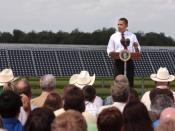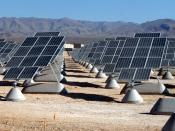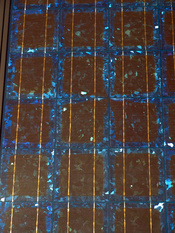Photovoltaic Panels
Photovoltaic panels, more commonly known as solar panels, are panels that are made up mostly of silicon that convert the energy given off by the sun into usable energy, such as electricity for homes. The word Photovoltaic means "light electricity." This is because light is changed into electricity. The first model for one of these panels was made in 1954. At first, they were just used for gathering electricity for space travel, but as time progressed, their usefulness and reliability was established. For the first twenty to twenty-five years of attaining one of these panels, one only has to make sure that it is clean enough to absorb the sunlight. Photovoltaic panels are a sensible source of alternative energy because they don't require much maintenance, are economically friendly, and use a renewable source of energy.
When light hits the panel, it is absorbed by the silicon, which then releases electrons.
The electrons are collected and turned into an electrical current, which is then stored or used to power electrical devices. Most photovoltaic panels consist of four to five layers: a protective top layer with electron-collecting circuitry, two specially treated silicon layers, a polymer bottom layer, and an optional frame for durability. The silicon works as a semiconductor, so when it is hit by photons (light energy), the silicon raises its electrons to a higher level, knocking some loose in the process. The top silicon layer is negatively charged (electron rich), and the bottom layer is positively charged (electron poor). In between these layers is an electric junction that allows a one-way flow of electrons from the back of the panel to the front. Electrical contacts on the top layer collect the electrons and route them to where they are needed as an electric current. The process ends when...


